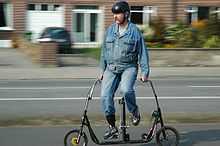Sideways bike


The sideways bike is an invention, patented in 2005,[1] by Michael Killian, a software engineer from Dublin. He was inspired by the way that snowboarding is preferred to skiing due to the greater artistic potential, and decided to design a snowboard equivalent for the conventional bicycle. The result: a bike ridden sideways with the rider operating both wheels. The bike, unlike a conventional bike, uses front-to-back balance like a snowboard. Conventional bikes use left-to-right balance, like skis.
Bicycle design
The sideways bike is different in many ways from a conventional diamond-framed bicycle. The rider controls direction by steering with both front and back handlebars. This means that the bicycle can maneuver effectively in congested conditions, weaving in and out of cars and performing tight turns. It also means that the rider can move the bike sideways, as the name suggests, such that the movement is perpendicular to the direction in which the frame points. Although this is possible, it is very difficult, as it is necessary for the rider to have extremely good balance and coordination.
The position of the pedals and cranks varies from bike to bike. Some sideways bicycles have them positioned in the same way that a normal bike does; however, there are some that are placed such that the rider must sit not facing in the direction of movement but perpendicular to it. This means that turning is easier and more elegant; however, visibility is impaired as the rider must turn his or her neck all the time.
Sideways bikes are single speed, which means that gears have not yet been worked into the complex design of transmission of power from the cranks to the back wheel. Since it pivots, a normal chain system cannot function, but Killian created a part that allows the rear cassette to cause the wheel to rotate even when turning, by having an intermediate piece that can transmit the power.
Rather than using a normal saddle for a bike, the sideways bike uses a unicycle saddle to aid balance.
The sizes of the wheels vary considerably between different sideways bikes in order for each bike to be adapted to its purposes correctly.
Advantages and disadvantages over conventional bikes
Advantages
- Due to the nature of its steering mechanism, the sideways bike has the potential for extremely small turning radii.
Disadvantages
- Overlean is a common error that new riders make, caused by leaning too far over when cornering.
- Parts are highly specialized because of such a low volume of riders.
- Neck aches are a common complaint since riders must constantly adjust their positions, depending on which side of the road cars drive.
See also
References
External links
- Sidewaysbike.com
- BBC
- Michael Killian pitches his invention to the Dragon's Den investors, BBC Sport Relief fund raising event, March 2010.
- Gizmag
- New Zealand Herald
- International Herald Tribune, April 6, 2007
- U.K. Times
- Kevin Saylor, "A bicycle built for few" Knoxville News Sentinel, August 18, 2006
| |||||||||||||||||||||||||||||||||||||||||||